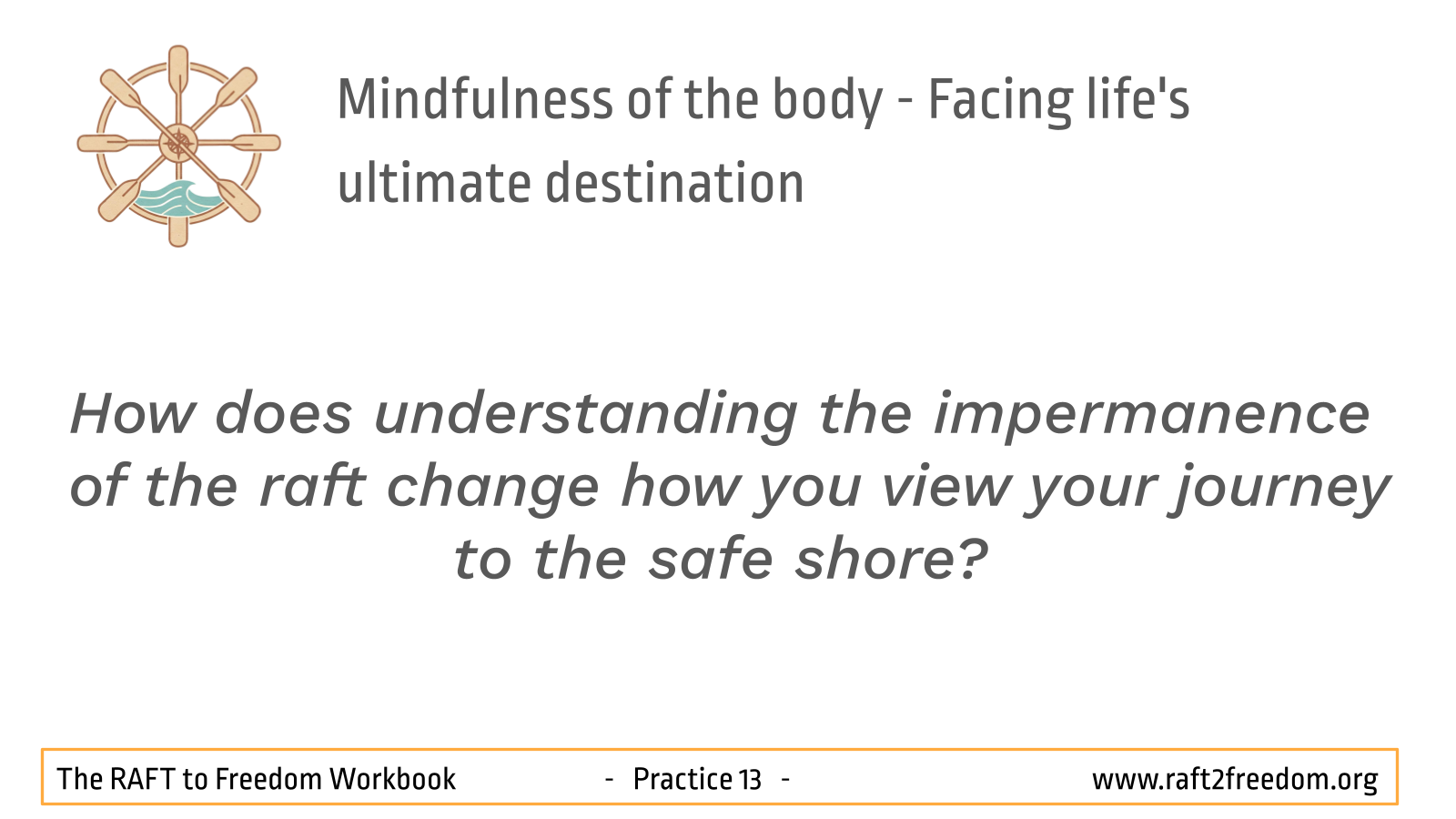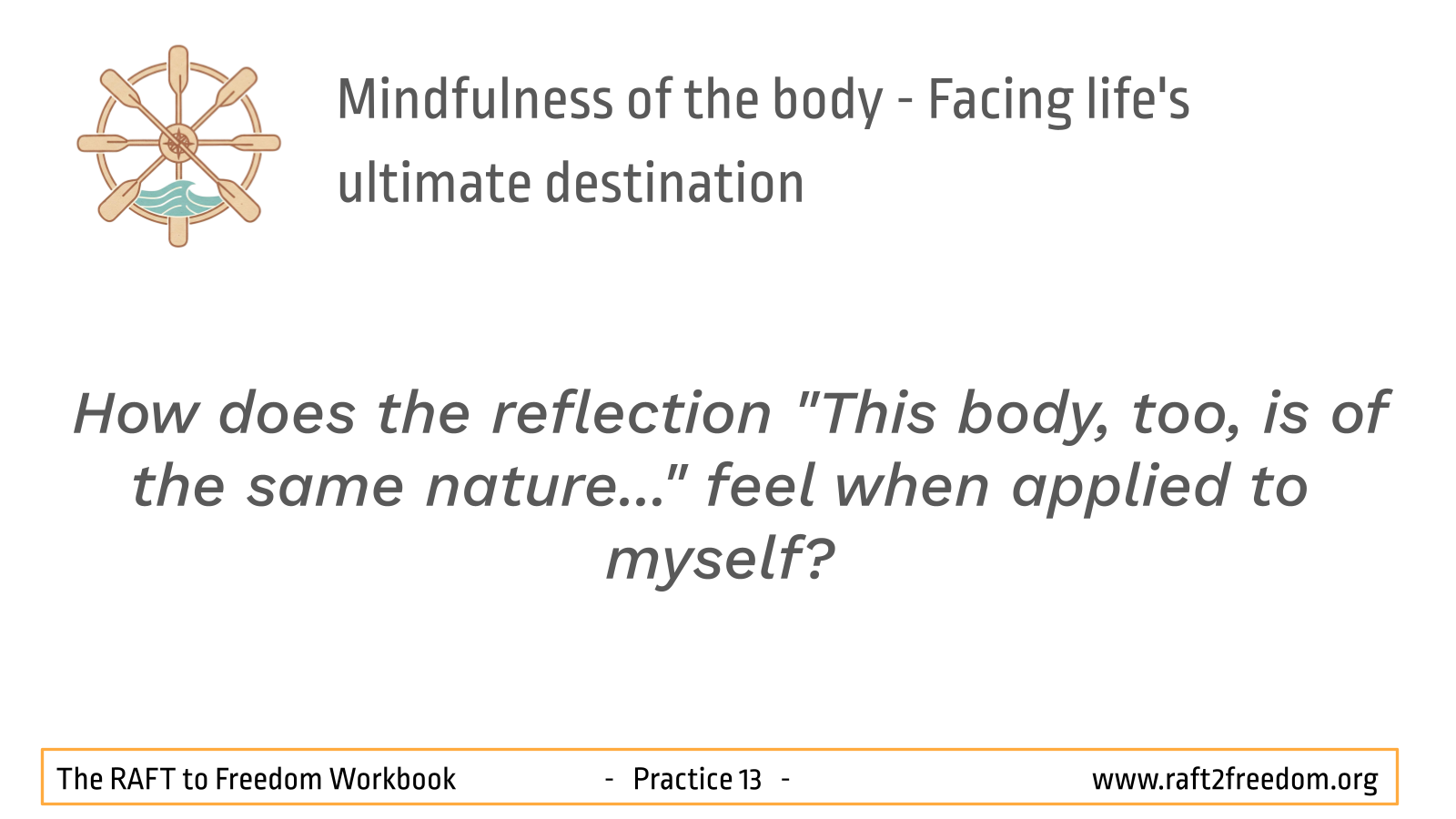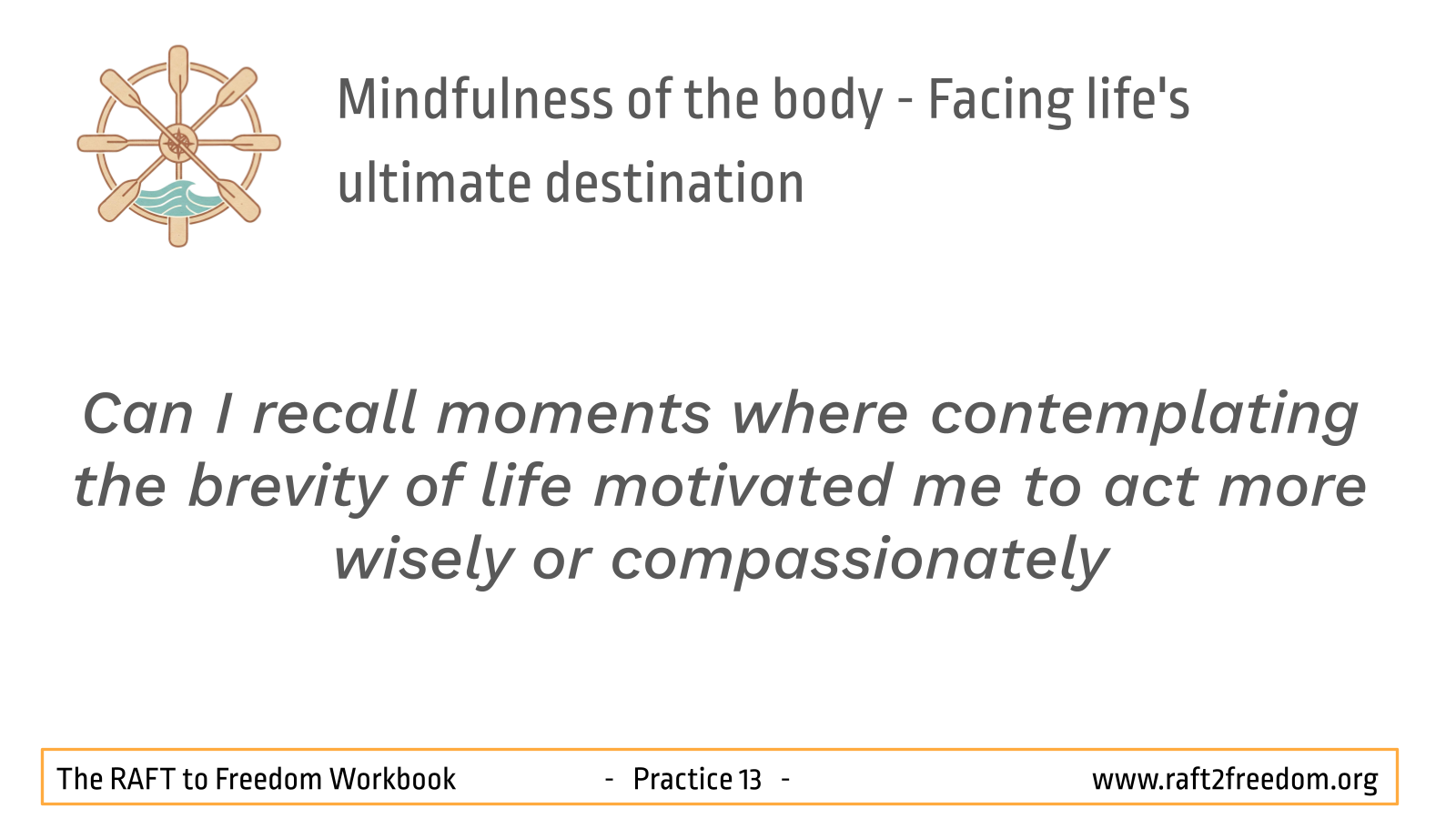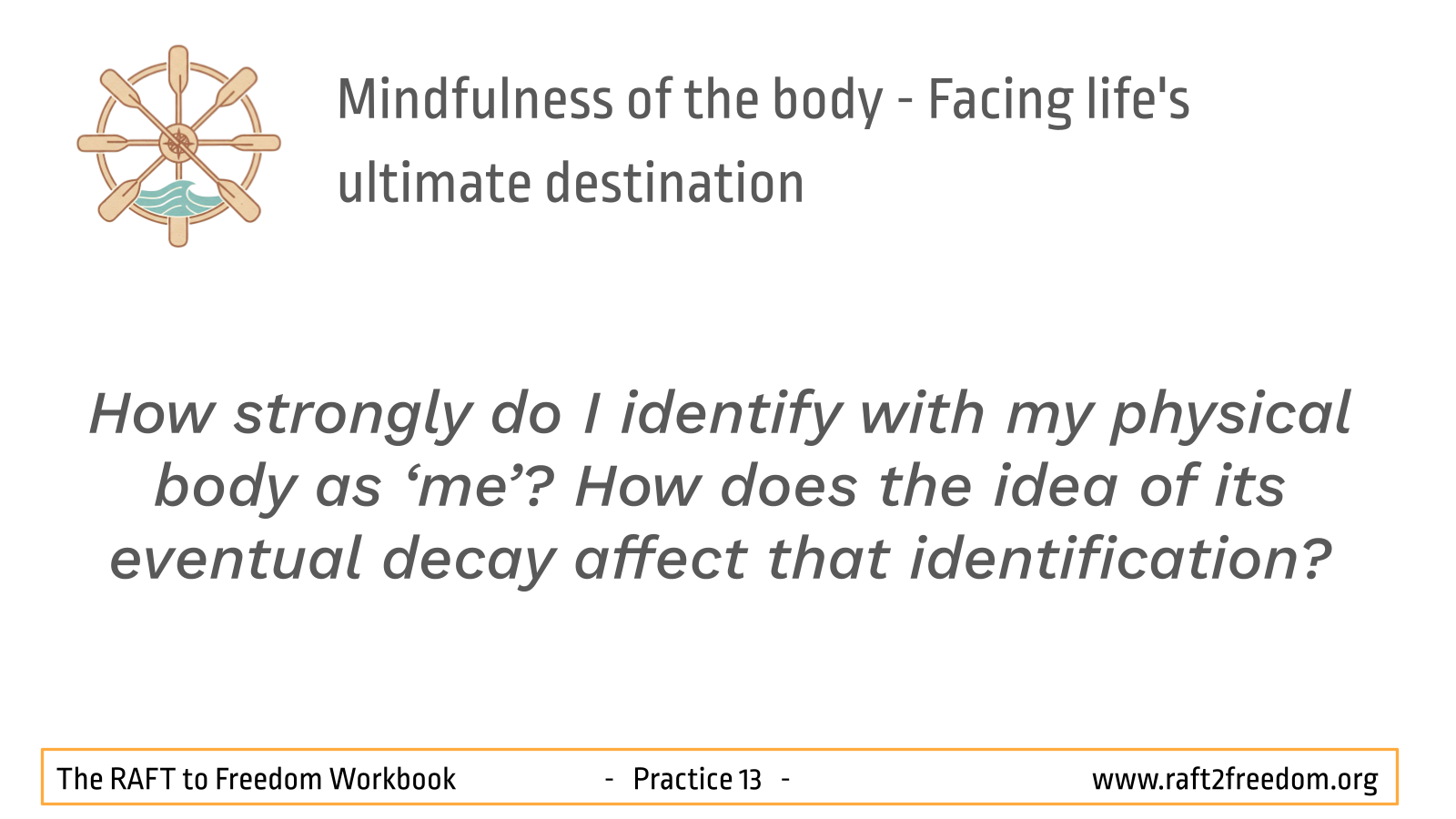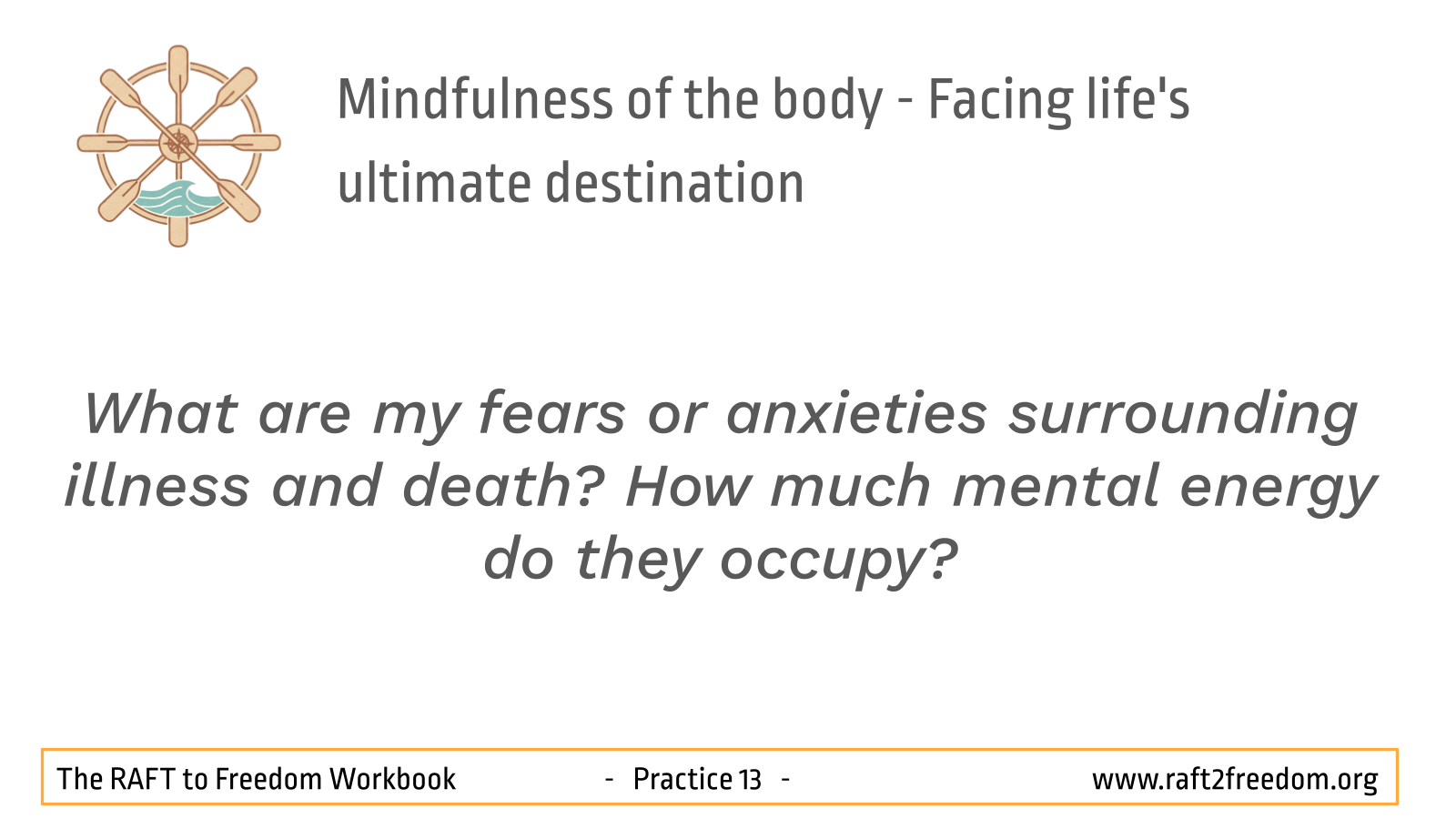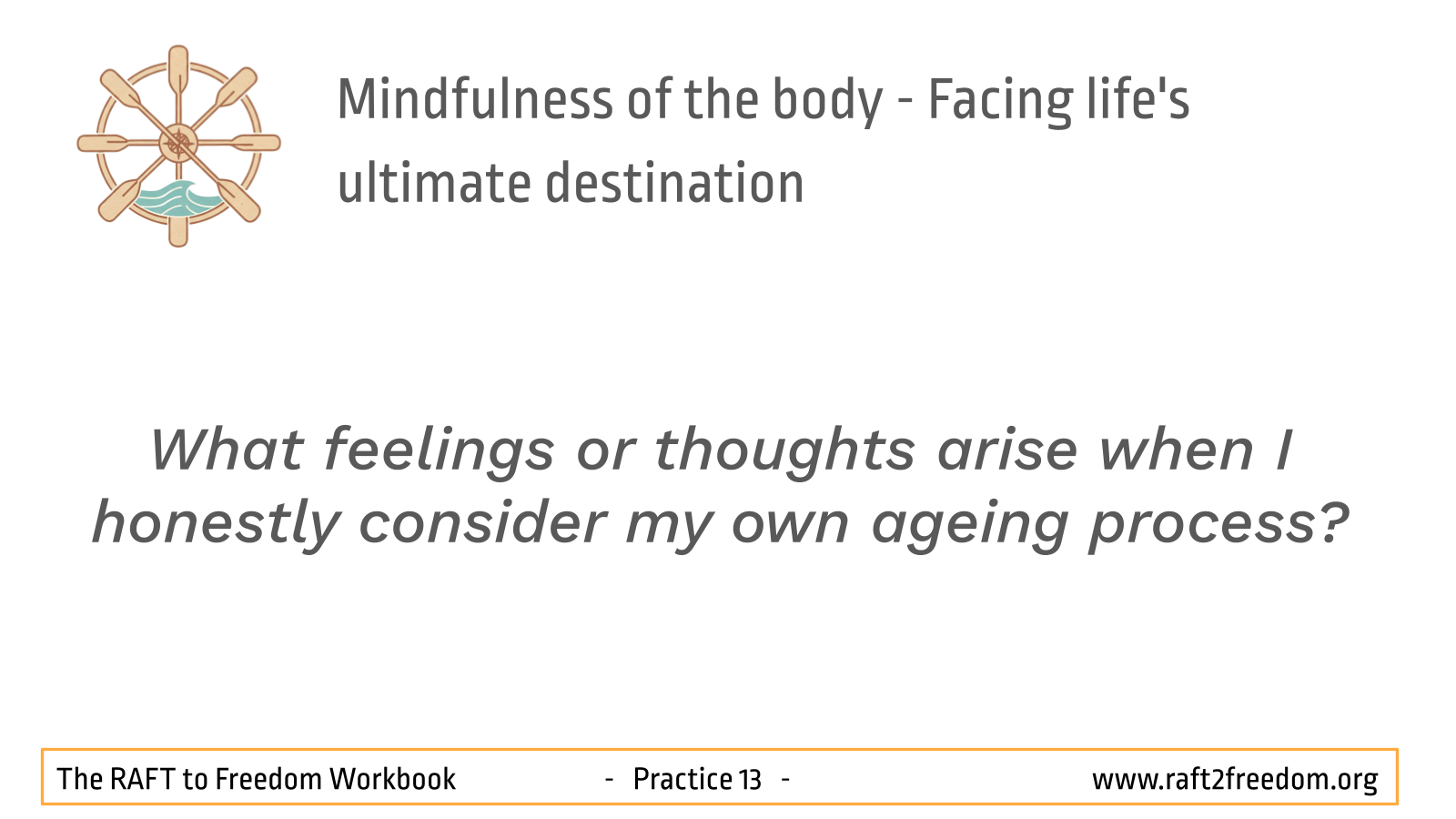Practice 13 – Mindfulness of the Body: Contemplating change, ageing, and death
Recognising the impermanent nature of our raft
All conditioned things are impermanent. When one sees this with wisdom, one turns away from suffering.
Gotama – The Buddha

Episode 13 – Mindfulness of the Body: Contemplating change, ageing, and death
An AI generated ‘deep dive’ into this aspect of the RAFT to Freedom
We now arrive at the sixth and final exploration within the First anchor of mindfulness (mindfulness of the body), serving to help us recognise what it is to be human. This practice delves into the profound and often challenging territory of the body’s ultimate impermanence, looking at the body through the lens of ageing, sickness, death, and decomposition. Traditionally, this includes the contemplation known as mindfulness of death.
It is vital to approach this practice with wisdom, clarity of purpose, and self-compassion. The intention is not to cultivate morbidity, disgust, aversion, or self-hatred. As Gotama – the Buddha – cautioned against extremes, this practice should not lead to self-affliction. Rather, its purpose, when undertaken skillfully, is deeply liberating:
- To radically confront and overcome our deep-seated attachment to the body and to life itself.
- To cultivate profound equanimity – self-balance – in the face of the unavoidable inevitability of change, loss, and our mortality.
- To deepen our experiential understanding of impermanence – seeing that all things are constructed, including our bodies, and they arise and pass away.
- To generate spiritual urgency – a clear comprehension of the preciousness and fragility of life, motivating us to practice diligently right now!
- To reduce our fear of death through mindful familiarisation.
- To gain insight into non-identity (not-self), seeing our body as a natural process governed by conditions, rather than a permanent ‘me’ or ‘mine’ or ‘myself’.
- To develop dispassion towards fleeting sensual pleasures and worldly pursuits, changing our orientation towards lasting peace.
In Gotama’s famous talk on the four anchors of mindfulness, he describes the ‘charnel ground contemplations’ where one observes corpses in various stages of decomposition – bloated, discoloured, festering, being eaten, reduced to bones and turning to dust. Gotama describes the practice in detail as a sequence of contemplations focused on the decomposition of a corpse. We are invited to visualise or directly observe various stages of decay to reflect on the nature of our bodies. The key passages describe observing a corpse in stages of decay such as:
- Swollen and bloated.
- Discoloured and festering.
- Gnawed by animals, dismembered, and scattered.
- Reduced to a skeleton with flesh and blood.
- Bones scattered and eventually reduced to dust.
We are advised to reflect on the reality:
“My body, too, is of the same nature, it will be like that, it is not exempt from that fate.”
This direct reflection aims to break through our denial and see our body’s true nature without romanticisation or aversion. For many modern practitioners without access to actual charnel grounds, this contemplation is done through visualisation or reflection on the natural processes of decay observed elsewhere. Although this practice is ancient and traditional, it still continues to be practiced by some monastics today.
Applying this within our RAFT to Recovery metaphor, this practice involves recognising the ultimate impermanence of the raft itself. This vessel, which we are carefully constructing and navigating, is made of conditioned materials that will eventually wear out and dissolve back into the elements. This does not negate the vital importance of building the raft and making the journey to the safe shore; rather, it underscores the urgency to use this vessel skillfully and purposefully while we have the opportunity. It prevents us from mistaking the raft for the final destination or clinging to it possessively.
Benefits & modern adaptations: finding skillful means
Given the challenging nature of directly contemplating decomposition, it’s crucial to adapt this practice wisely, especially in a recovery context where we may be dealing with trauma or heightened sensitivity. The benefits can still be accessed through gentler, yet still profound, reflections:
- Mindfulness of ageing: Observing the subtle (or not-so-subtle) signs of ageing in ourselves and others with acceptance and kindness, rather than aversion or denial.
- Contemplating natural cycles: Reflecting on the cycles of birth, growth, decay, and death observed in nature (plants, animals, seasons) and seeing our own body as part of this natural flow.
- Appreciating the present moment: Using our awareness of life’s fragility to deepen our gratitude for the present moment and the capacities we currently have.
- Reflecting on loved ones: In gently contemplating the life cycle of relatives or loved ones who have passed, including the impersonal nature of the bodily dissolution after death, we can foster acceptance of this natural and universal process.
- Focusing on impermanence generally: Applying the understanding that everything changes – all our experiences including physical sensations, thoughts, emotions, and the body itself.
Remember to remember: This practice may not be suitable for everyone at all times. If it evokes overwhelming fear, disgust, aversion, or traumatic memories, it is essential to gently set it aside and focus on other supportive practices like mindfulness of breath, self-compassion, or connecting with resources offered elsewhere in this workbook. The Five Gifts always provide a grounding in non-harming, including towards ourselves. We should always prioritise our safety and well-being, and seek professional support if needed.
When approached skillfully, this practice is a powerful tool cultivating radical acceptance and reducing our suffering, which are central to our long-term recovery. Remember, these six lenses of body mindfulness are complementary tools; use the ones that feel most beneficial for you at this point in time.
Mindfulness of ageing and decay in addiction recovery
We are here to awaken from the illusion of our separateness. The body is a temporary vessel, and we must learn to see it as such.
Thich Nhat Hanh
Approached skillfully and appropriately, this contemplation offers unique support:
- Undermining attachment to fleeting highs: Recognising our body’s ultimate impermanence starkly contrasts with our addictive pursuit of temporary, body-based pleasures, highlighting their ultimate futility and unsatisfactoriness.
- Reducing urgency of cravings: In understanding that all phenomena, including cravings and the body that experiencing them, are transient, can reduce our perceived need to immediately act on an urge. ‘This too shall pass’ gains a deeper meaning.
- Motivating meaningful recovery: Awareness of our life’s fragility can powerfully motivate us to use our time wisely, and commit fully to our recovery, heal relationships, and cultivate qualities that endure beyond our physical form, rather than wasting our precious life energy on harmful patterns and behaviours. Understanding impermanence changes our mis-perception that cravings and difficult emotions are permanent.
- Shifting identity: Contemplating our body’s dissolution weakens our self-identification with it, and by extension, the other identities tied to it – including the ‘addict’ or ‘victim’ identity. It opens space for a broader sense of our ‘self’ grounded in awareness and our values.
- Contextualising suffering: Placing our personal struggles within the universal context of birth, aging, sickness, and death can sometimes lessen their isolating sting, cultivating a sense of our shared humanity.
- Developing resilience through acceptance: When we practise acceptance of unavoidable realities, like impermanence, we build psychological resilience which is applicable to accepting the discomfort of our cravings or our difficult emotions without needing to escape from them.
Self-Reflections
Approach these reflections gently, with self-compassion:
- What feelings or thoughts arise when I honestly consider my own ageing process?
- What are my fears or anxieties surrounding illness and death? How much mental energy do they occupy?
- How strongly do I identify with my physical body as ‘me’? How does the idea of its eventual decay affect that identification?
- Can I recall moments where contemplating the brevity of life motivated me to act more wisely or compassionately?
- How does the reflection “This body, too, is of the same nature…” feel when applied to myself?
- How does understanding the impermanence of the raft change how you view your journey to the safe shore?
Journaling prompts
Explore these themes in writing, remembering to be kind to yourself:
- Signs of impermanence: Spend some time observing signs of impermanence in your body (for example, your changing hair, skin and energy levels) or in the world around you (for example, the weather and plants). Write about the feelings of constant change.
- Living values: Given that life is finite and the body impermanent, what truly matters most to you? What values do you want to live by during the time you have? How does this reflection impact your recovery priorities?
- Gentle recollection of death: Set aside a few minutes to sit quietly and contemplate the simple fact: “Death is certain; the time of death is uncertain.” Notice any thoughts, feelings, or bodily sensations that arise, holding them with gentle awareness and compassion. Write about the experience.
- Adapting the practice: If the direct contemplation of decay feels unsuitable, reflect on which alternative practice resonates more (for example, mindfulness of aging, contemplating nature’s cycles, focusing on gratitude for the present). Write about why that alternative feels more supportive for you now.
Supporting material: scientific and philosophical perspectives
For those interested in the scientific and philosophical underpinnings of mindfulness of ageing and death, the following overview highlights some key connections.
- Neuroscience: Research into Terror Management Theory (TMT) suggests that awareness of mortality (mortality salience) can trigger defensive reactions but also potentially motivate prosocial behaviour and adherence to cultural values. Mindfulness training may help modulate the brain’s fear circuits (amygdala) and enhance prefrontal cortex activity associated with emotional regulation, potentially allowing individuals to process existential anxieties like death awareness with less reactivity.
Regular meditation increases gray matter in areas of the brain related to memory, self-awareness, and emotional control, which is critical for overcoming addictions and compulsions. Contemplative practices can normalise dopamine levels, which are frequently dysregulated in addiction, thereby reducing cravings and enhancing self-control. This could shift brain activity away from reward-seeking towards meaning-making pathways. Meditation lowers cortisol levels and activates the parasympathetic nervous system, reducing stress – a common trigger for relapse.
- Psychology: TMT research explores how humans cope with the awareness of death, often by investing in cultural worldviews or self-esteem. Acceptance and Commitment Therapy (ACT) encourages accepting unavoidable realities, including mortality, to free up energy for living a life aligned with personal values. Facing finitude can clarify priorities and increase appreciation for life (gratitude). While direct exposure to graphic decay imagery isn’t standard therapy, graded exposure to feared concepts (like death) can reduce anxiety over time. For those with trauma, however, such practices must be approached with extreme caution or avoided.
‘Death cafes’ are increasingly available, where people can come together to discuss death over food and drink – usually tea and cake. The goal is to increase awareness of death and help people make the most of their lives. These are not grief support groups, but rather places for an open, facilitated conversation about death and dying.
Contemplating the decay of the body aligns with mindfulness-based strategies of developing acceptance and non-attachment. This helps reduce the power of cravings by cultivating a perspective shift away from immediate gratification.
- Philosophy: Existentialism places confrontation with finitude, death, and meaninglessness at its core, arguing that authentic living arises from acknowledging these realities. Stoicism advocates calm acceptance of death as a natural and inevitable process, urging focus on living virtuously in the present. Epicureanism sought to alleviate fear of death by arguing that while we exist, death is not present, and when death is present, we do not exist. Buddhist philosophy universally emphasises impermanence and recollection of death as crucial catalysts for wisdom, detachment, and liberation.
These diverse perspectives underscore the timeless relevance of contemplating impermanence, as in our own death and decay, a theme we now bring to a close in this practice.
Remember to Remember
From the breath of life to the dust of death, mindfulness of the body’s impermanence, encompassing reflections on ageing, decay, and death, represents the culmination of our body exploration in this First Anchor of Mindfulness. It is a challenging yet potentially transformative practice aimed squarely at uprooting our deepest attachments and fears by confronting Gotama’s First Reality: Life is painful, difficult and disappointing and then you die! From our first breath at birth, until our final breath before the break-up of our body – which bookend aging and sickness.
In its most undeniable form, it completes our initial survey of our RAFT’s materials, highlighting that they are dependent on conditions and, as with all things, are temporary, transient, and impermanent.
Two thousand six hundred years ago, Gotama said:
“There are those who do not realise that one day we all must die;
but those who do realise this, settle their quarrels”.
And a thousand years later, the 5th-century Indian scholar Buddhaghosa, in his epic commentary ‘The Path of Purification’, described forty different types of meditation, emphasising that only two are said to be always and under all circumstances beneficial: that is, the cultivation of friendliness, and the recollection of death.
The body is like a water bubble, it is here for a moment and then it is gone. Contemplate this and you will find peace.
Ajahn Chah
Remember, this practice demands wisdom, balance, and profound self-compassion. It is not about forcing ourselves into morbid states but about gently and persistently cultivating realistic insight to foster liberation. We can adapt the practice, focus on impermanence generally, or choose other methods if needed. The ultimate aim, as with all these practices, is the reduction of suffering and the cultivation of peace. Having now explored the body through these six lenses, we gain a much clearer, more grounded recognition of our starting point, preparing us to investigate further aspects of human experience on the first stage of our journey.
With a greater sense of understanding comes a greater sense of wonder, and a greater realisation that we are part of and not apart from the rest of nature. And, when the end of consciousness comes, there is nothing to be afraid of, nothing at all.
Anil Seph
Sutta References
- Satipaṭṭhāna Sutta (MN 10 / DN 22 – The Foundations of Mindfulness): Contains the detailed ‘Charnel Ground Contemplations’.
- Summary: This section provides graphic descriptions of a corpse in nine stages of decomposition, from bloated and discoloured to crumbling dust. For each stage, the instruction is to reflect, “This body, too, is of the same nature, it will be like that, it is not exempt from that fate,” fostering insight into impermanence and non-attachment.
- Maranasati Sutta (AN 6.19 / AN 6.20 – Mindfulness of Death): Suttas focusing specifically on the practice and benefits of contemplating death.
- Summary: The Buddha encourages frequent reflection on the possibility and inevitability of death, stating that one who develops mindfulness of death diligently is heedful, develops dispassion for attachment to life, overcomes evil, and lives without longing, ultimately heading towards the Deathless (Nibbana).
- Anguttara Nikaya 3.63 (Regarding extremes): Although not directly about maranasati, this passage warns against the extremes of sensual indulgence and self-mortification.
- Summary: The Buddha advises monks to avoid both addiction to sensual pleasures and devotion to self-torment, recommending the Middle Way. This is relevant context for ensuring that contemplating decay does not become a form of self-aversion or unhealthy asceticism.
- Kāyagatāsati Sutta (MN 119 – Mindfulness Directed to the Body): Reinforces the value of body contemplations, including those related to impermanence and composition.
- Summary: This sutta emphasises that consistent mindfulness directed to the body, encompassing practices like contemplating its parts, elements, and impermanent nature, leads to great benefits, including the attainment of higher knowledge and liberation.
RAFT to Freedom © 2025 by Dr Cathryn Jacob and Vince Cullen is licensed under CC BY-NC-SA 4.0. To view a copy of this license, visit https://creativecommons.org/licenses/by-nc-sa/4.0/ |
